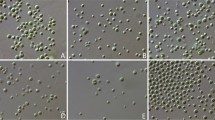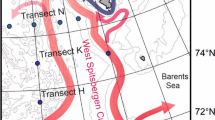Abstract
The termite Zootermopsis nevadensis nuttingi, which inhabits coastal forests of the western United States, plays an important ecological role in the breakdown and digestion of wood. Vital to this role are symbiotic protists residing in the termite’s hindgut. Five protist genera of varying size and morphology make up this gut community, but very little is known about their spatial organization within the hindgut or the number of protist cells per host. To resolve this issue, we used light microscopy and a hemocytometer to determine the distribution of the larger protist genera across hindgut segments. We found that Streblomastix were the most abundant cells in all three segments, but especially in the anterior hindgut. Trichomitopsis cells were significantly more abundant in the posterior hindgut. Trichonympha were the least abundant overall, often reaching their highest abundance in the middle segment but with a more variable distribution. Understanding the distribution of different protists within the hindgut may improve our understanding of the ecological relationships among protists, as well as their individual roles in lignocellulose digestion, contributing to a better understanding of the symbiotic system as a whole.



Similar content being viewed by others
References
Aldrich BT, Maghirang EB, Dowell FE, Kambhampati S (2007) Identification of termite species and subspecies of the genus Zootermopsis using near-infrared reflectance spectroscopy. J Insect Sci 7
Berchtold M, Breunig A, König H (1995) Culture and phylogenetic characterization of Trichomitus trypanoides (Duboscq) & (Grassè) 1924, n. comb.: a trichomonad flagellate isolated from the hindgut of the termite Reticulitermes santonensis (Feytaud). J Eukaryot Microbiol 42:388–391
Bignell DE, Anderson JM (1980) Determination of pH and oxygen status in the guts of lower and higher termites. J Insect Physiol 26:183–188
Breznak JA, Brune A (1994) Role of microorganisms in the digestion of lignocellulose by termites. Annu Rev Entomol 39:453–487
Brugerolle G, Radek R (2006) Symbiotic Protozoa of termites. In: Konig and Varma, (eds) intestinal microorganisms of termites and other invertebrates. Springer. p. 243–269
Brune A (2014) Symbiotic digestion of lignocellulose in termite guts. Nat Rev Microbiol 12:168–180
Brune A, Emerson D, Breznak JA (1995) The termite gut microflora as an oxygen sink: microelectrode determination of oxygen and pH gradients in guts of lower and higher termites. Appl Environ Microbiol 61:2681–2687
Cleveland LR (1924) The physiological and symbiotic relationships between the intestinal Protozoa of termites and their host, with special reference to Reticulitermes flavipes (Kollar). Biol Bull 46:178–201
Cleveland LR (1925) The effects of oxygenation and starvation on the symbiosis between the termite, Termopsis, and its intestinal flagellates. Biol Bull 48:309–326-1
Cook TJ, Gold RE (2000) Effects of different cellulose sources on the structure of the hindgut flagellate community in Reticulitermes virginicus (Isoptera: Rhinotermitidae). Sociobiology 35:119–130
Dyer BD, Khalsa O (1993) Surface bacteria of Streblomastix strix are sensory symbionts. BioSystems 31:169–180
Eutick ML, Veivers P, O’Brien RW, Slaytor M (1978) Dependence of the higher termite, Nasutitermes exitiosus and the lower termite, Coptotermes lacteus on their gut flora. J Insect Physiol 24:363–368
Honigberg BM (1970) Protozoa associated with termites and their role in digestion. Biol Termites:1–36
Kidder GW (1929) Streblomastix strix, morphology and mitosis. University of California Publications in Zoology 33:109–124
Kirby H (1930) Tricercomitus gen. nov. and Hexamastix (Alexeieff). In: Trichomonad flagellates from termites, I. Berkeley: University of California press. p. 393–444
Kitade O, Matsumoto T (1993) Symbiotic protistan Faunae of Reticulitermes (Isoptera : Rhinotermitidae) in the Japan archipelago. Sociobiology 23:135–153
Kofoid CA, Swezy O (1919). II. On Trichomitopsis termopsidis, a polymastigote flagellate with a highly developed neuromotor system. In: studies on the parasites of the termites. Vol. 20. University of California Press. p. 21–40
Lai PY, Tamashiro M, Fujii JK (1983) Abundance and distribution of the three species of symbiotic protozoa in the hindgut of Coptotermes formosanus (Isoptera: Rhinotermitidae). Proc Hawaiian Entomol Soc 24:271–276
Leander BS, Keeling PJ (2004) Symbiotic innovation in the oxymonad Streblomastix strix. J Eukaryotic Microbiol 51:291–300
Li L, Fröhlich J, König H (2006) Cellulose digestion in the termite gut. Intestinal microorganisms of termites and other invertebrates. Springer, In, pp 221–241
Lund E (1930) The effect of diet upon the intestinal fauna of termopsis. University of California Publications in Zoology 36:81–96
Mannesmann R (1972) Relationship between different wood species as a termite food source and the reproduction rate of termite symbionts. Z Angew Entomol 72:116–128
Mauldin JK, Carter FL, Rich NM (1981) Protozoan populations of Reticulitermes flavipes (Kollar) exposed to heartwood blocks of 21 American species. Material und Organismen (Germany, F.R.):15–28
Noda et al (2006) Identification and characterization of ectosymbionts of distinct lineages in Bacteroidales attached to flaggellated protists in the gut of termites and wood-feeding cockroach. Environ Microbiol 8:11–20
Noirot C (1995) The gut of termites (Isoptera) -compartive anatomy, systematics, phylogeny. I Lower Termites Annales de la Societe Entomologique de France 31:197–226
Porter JF (1897) Trichonympha and other parasites of Termes flavipes. Bull Mus Comp Zool 47:45–68
Scharf ME, Karl ZJ, Sethi A, Sen R, Raychoudhury R, Boucias DG (2011) Defining host-symbiont collaboration in termite lignocellulose digestion: “The view from the tip of the iceberg.”. Commun Integrat Biol 4:761–763
Taerum SJ, De Martini F, Liebig J, Gile GH (2018) Incomplete co-cladogenesis between Zootermopsis termites and their associated protists. Environ Entomol 47:184–195
Tai V, James ER, Perlman SJ, Keeling PJ (2013) Single-cell DNA barcoding using sequences from the small subunit rRNA and internal transcribed spacer region identifies new species of Trichonympha and Trichomitopsis from the hindgut of the termite Zootermopsis angusticollis. PLoS One 8:e58728
Tamschick S, Radek R (2013) Colonization of termite hindgut walls by oxymonad flagellates and prokaryotes in Incisitermes tabogae, I. marginipennis and Reticulitermes flavipes. European J of Protistol 49:1–14
Terrapon et al (2014) Molecular traces of alternative social organization in a termite genome. Nat Commun 5:1–12
Thorne BL, Haverty MI, Page M, Nutting WL (1993) Distribution and biogeography of the north American termite genus Zootermopsis (Isoptera: Termopsidae). Ann Entomol Soc Am 86:532–544
Tokuda G, Lo N, Watanabe H, Slaytor M, Matsumoto T, Noda H (1999) Metazoan cellulase genes from termites: intron/exon structures and sites of expression. Biochimica et Biophysica Acta (BBA) - Gene Structure and Expression 1447:146–159
Tokuda G, Tsuboi Y, Kihara K, Saitou S, Moriya S, Lo N, Kikuchi J (2014) Metabolomic profiling of 13C-labelled cellulose digestion in a lower termite: insights into gut symbiont function. Proc R Soc B 281:20140990
Watanabe H, Noda H, Tokuda G, Lo N (1998) A cellulase gene of termite origin. Nature 394:330–331
Xie L, Zhang L, Zhong Y, Liu N, Long Y, Wang S, Zhou X, Zhou Z, Huang Y, Wang Q (2012) Profiling the metatranscriptome of the protistan community in Coptotermes formosanus with emphasis on the lignocellulolytic system. Genomics 99:246–255
Yamaoka I, Ideoka H, Sasabe K, Nagatami Y (1983) Distribution of the intestinal flagellates in the hindgut of the termite, Reticulitermes speratus (Kolbe). Ann Entomol 1:45–50
Yamin MA (1978) Axenic cultivation of the cellulolytic flagellate Trichomitopsis termopsidis (Cleveland) from the termite Zootermopsis. J Protozool 25:535–538
Yamin MA (1979) Flagellates of the orders Trichomonadida (Kirby), Oxymonadida (Grass), and Hypermastigida (Grassi) and Foa reported from lower termites (Isoptera families Mastotermitidae,Kalotermitidae, Hodotermitidae, Termopsidae, Rhinotermitidae, and Serritermitidae) and from the wood-feeding roach Cryptocercus (Dictyoptera : Cryptocercidae). Sociobiology 4:1–120
Yamin MA (1981) Cellulose metabolism by the flagellate Trichonympha from a termite is independent of endosymbiotic bacteria. Science 211:58–59
Yoshimura T (1992) Distribution of the symbiotic protozoa in the hindgut of Coptotermes formosanus Shiraki (Isoptera; Rhinotermitidae). Jpn J Environ Entomol Zool 4:115–120
Yoshimura T (1995) Contribution of the protozoan fauna to nutritional physiology of the lower termite, Coptotermes formosanus (Shiraki) (Isoptera: Rhinotermitidae). Wood Res 82:68–129
Acknowledgements
This study was submitted in partial requirement of a Bachelor of Science Honors Degree at Barrett, The Honors College, at Arizona State University for CP. The authors would like to thank Jürgen Liebig and Kevin Haight for providing termites and an anonymous reviewer for thoughtful and helpful suggestions.
Author information
Authors and Affiliations
Corresponding author
Additional information
Publisher’s note
Springer Nature remains neutral with regard to jurisdictional claims in published maps and institutional affiliations.
Electronic supplementary material
ESM 1
(XLSX 17 kb)
Rights and permissions
About this article
Cite this article
Piarowski, C.M., De Martini, F. & Gile, G.H. Distribution and relative abundance of three protist genera within the Zootermopsis nevadensis nuttingi hindgut. Symbiosis 79, 231–238 (2019). https://doi.org/10.1007/s13199-019-00641-3
Received:
Accepted:
Published:
Issue Date:
DOI: https://doi.org/10.1007/s13199-019-00641-3




